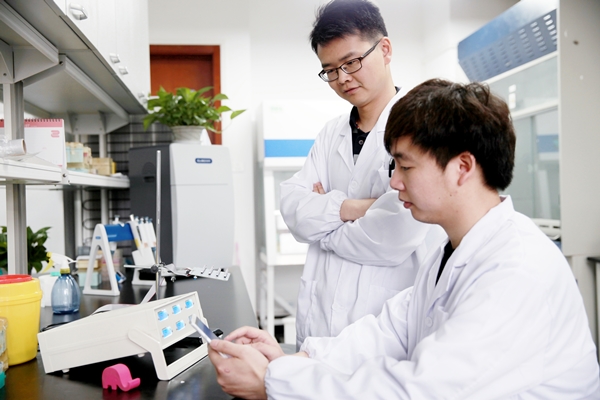
Haifeng Ye, standing, and first author Jiawei Shao operate the smartphone system controlling pancreas cells. (East China Normal University)
27 April 2017. A system designed by researchers in China and Switzerland and controlled by a smartphone app was shown in lab mice to produce insulin on demand from engineered pancreas cells. The team from East China Normal University in Shanghai and ETH Zürich describe the system in yesterday’s issue of the journal Science Translational Medicine (paid subscription required).
Researchers led by Haifeng Ye from the university’s Laboratory of Regulatory Biology are seeking better solutions for people with diabetes to manage their condition, which requires careful monitoring of blood glucose levels and injections of insulin. Diabetes is a chronic disorder affecting some 422 million people worldwide in 2014, where the pancreas does not create insulin to process the glucose to flow through the blood stream and provide energy for cells in the body. In type 2 diabetes, which accounts for 90 to 95 percent of all diabetes cases, the pancreas produces some but not enough insulin, or the body cannot process insulin. Type 1 diabetes is a condition where the immune system attacks and stops beta cells in the pancreas from producing insulin.
The team’s system combines synthetic pancreas cells, optical engineering, wireless electronics, and smartphone software. The synthetic pancreas cells are activated by beams in the far end of the visible light spectrum, called far-red light. This part of the spectrum, at the border of visible and infrared rays, can penetrate through skin and other tissue. The researchers combine these synthetic cells with tiny light-emitting diodes, or LEDs in hydrogel, or water-based polymer, capsules. These capsules are implanted into the skin, in this case of of lab mice, some of which are induced with diabetes.
The system has a glucose monitor to measure levels in blood from the tails of mice, with the monitor linked via Bluetooth to an Android smartphone and a system controller. When glucose levels reach designated thresholds, the controller sends signals to the smartphone indicating the need to activate the implanted pancreas cells. The individual sets the app on the phone to produce hormones for lowering blood glucose levels, either insulin or a form of glucagon-like peptide-1, for a specified period of time until desired glucose levels are reached.
The engineered pancreas cells respond to light waves either by firing the tiny LEDs packed in with the cells, or by external light sources. The pancreas cells are engineered with molecules adapted from light-sensitive bacteria to respond to either light source, and emit enzymes to trigger production of one of the hormones to lower blood glucose. The system went through a few iterations to remove issues with signals from the implanted capsules that could trigger unwanted immune system reactions.
After 3 iterations, the system was able to safely reduce glucose concentrations in the test mice, with those concentrations controlled by the human-operated smartphone app. Tests comparing healthy mice and those induced with type 2 diabetes show the system can reduce blood glucose levels on demand for 3 days. The researchers report the system continued working with the mice for several weeks.
The authors note the system requires human intervention and is not a closed-loop artificial pancreas. But the results suggest therapies for diabetes combining synthetic cells and electronics available to consumers are becoming feasible. East China Normal University filed for patents in China on several elements in the system.
More from Science & Enterprise:
- Phones, Algorithms Boost Adherence to Stroke Meds
- Artificial Pancreas Shown Feasible for Young Children
- Univ. Spin-Off Designing Heart Disease Screening App
- Mobile App Shown Feasible for Asthma Data
- Mobile App-Controlled Patch Reduces Migraine Pain
* * *

 RSS - Posts
RSS - Posts
You must be logged in to post a comment.